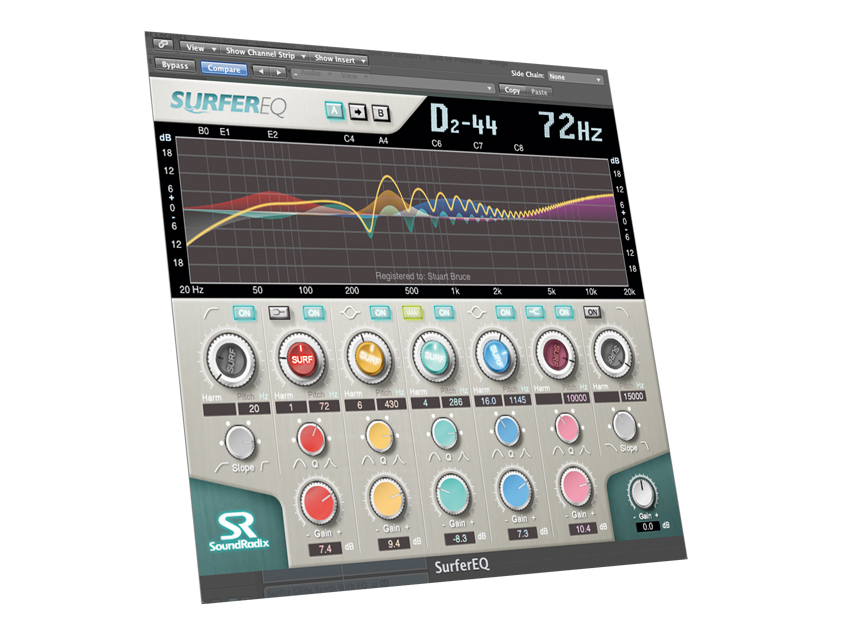MusicRadar Verdict
A really well-thought-out and innovative approach to EQ that gives us a new creative tool.
Pros
- +
Unique Harmonic Filter; a great-sounding EQ without the pitch tracking.
Cons
- -
Has difficulty tracking delay or reverb-treated sources.
MusicRadar's got your back
Sound Radix's first product was Auto-Align, reviewed back in 2010. While Auto-Align is an elegant solution to an age-old problem, the Surfer EQ is a radical new step in the way that we think about EQ.
Synthesiser filters can be made to track pitch but EQ has always been a static affair. The Surfer incorporates a pitch detection circuit that tracks a monophonic instrument or vocal source and moves the selected bands with the music. If you think about it this makes perfect sense.
"When the bands track the pitch you can balance the highs with some very cohesive lows, keeping the character while bringing the sound to the fore."
Monophonic sources are very often the lead instrument and can contain some pretty radical leaps in pitch. Enhancing the harmonic structure rather than just sticking on a bit of bass or treble should result in retaining the dynamic of the performance, especially with more extreme settings. So how does it work?
Surf's up
On first launching the Surfer looks similar to many other EQ plugs: a five-band parametric EQ with HF and LF filters. Each band is full range (20Hz to 20kHz) with a fou- position bandwidth control and +/-20dB of gain.
On closer inspection the coloured centre of the frequency knob is a switch which engages the 'Surf' circuit, and this is where things get really interesting. The easiest way to set up a 'tuned' EQ is by using the 'Harm' window just below the Freq knob. Choosing a monophonic source, you can dial in the octaves (or parts thereof) either from the alphanumeric or by turning the knob.
The pitch/freq readout in the top right hand corner tells you the detected pitch and next to the Harm window is a Freq version that gives most of us more of an idea which area be are working in. Boosting the fundamental or second harmonic adds weight and you can go on up bringing out the harmonics way up into the high end.
On the central band is another switch, which brings in the Harmonic Filter circuit. This has four harmonic enhancing filter shapes, which are set on individual bands using the bandwidth control. These add a harmonically rich additional tone to the sound, and with 20dB of cut and boost are very radical.
Pet sounds
As a straight EQ the Surfer sounds good. The word 'musical' fits it well: subtle when it needs to be but also capable of some radical re-arranging of the frequencies.
The detection circuit is excellent: we tried it on bass, voice, synth leads and pick guitar among a few other things. If the sound in question has any kind of significant release element it can go haywire, so sticking it over something with delay or reverb already recorded means it can't keep up, but with true mono sources it tracks accurately and very fast.
We really like the way it can put focus into a sound. Getting a lead line to stand out can be tricky and although it's tempting to add top for clarity that very action can make it sound brittle or thin.
When the bands track the pitch you can balance the highs with some very cohesive lows, keeping the character while bringing the sound to the fore and because it moves with the performance doesn't create lumps in certain pitch areas.
With extreme EQ settings the tracking means it stays musical and is capable of truly radical soundscaping. An excellent idea very well executed. Expect great things.
Future Music is the number one magazine for today's producers. Packed with technique and technology we'll help you make great new music. All-access artist interviews, in-depth gear reviews, essential production tutorials and much more. Every marvellous monthly edition features reliable reviews of the latest and greatest hardware and software technology and techniques, unparalleled advice, in-depth interviews, sensational free samples and so much more to improve the experience and outcome of your music-making.
“We were arguing a lot and we were miserable”: How Green Day exceeded expectations with their most ambitious song
"There’s plenty for us guitarists to learn – and ‘less is more’ is the overriding lesson": how to play like George Harrison on The Beatles' Abbey Road
“They didn’t like Prince’s bikini underwear”: Prince’s support sets for the The Rolling Stones in 1981 are remembered as disastrous, but guitarist Dez Dickerson says that the the crowd reaction wasn’t as bad as people think











